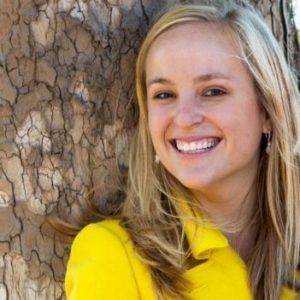Empowered Women Empower Women (I)
By: Allison Mihalich
January 2, 2018

[As a graduate student in Virginia Tech’s Executive Master of Natural Resources (XMNR) degree program, Allison Mihalich participated in an International Residency trip to India. In this four-part series, Mihalich describes efforts to empower women in the Thar Desert region of Rajasthan, India.]
In one of the world’s most water-distressed region, the Thar Desert in the Indian state Rajasthan, the Jal Bhagirathi Foundation (JBF) has worked tirelessly to connect people to clean and affordable water through empowering women to serve their villages as agents of change. The problems facing villages in the Thar Desert include chronic aridity, low annual rainfall, frequent severe droughts, lack of viable crops, and arduous daily treks to haul what groundwater is available.
The burden of these water related crises fall heavily on women and girls, the natural resource managers, whose contributions are unpaid and often unaccounted for in economic, political, or social systems. When even government provisions of water fall short, there still remains hope, thanks in large part to the JBFs approach of empowering women and girls to have a voice in managing water resources, participating in self-help groups, and bettering their quality of life through access to credit.
The outcomes of the JBFs efforts are captured by its many accolades, village success stories, and replicability across villages. This case outlines how the JBF empowers women at three distinct levels: executive, program staff, and village. It will also describe how empowered women aided or employed by the JBF have improved quality of life for themselves and others.

Why Empower Women?
Gender equality and female empowerment are not only the beneficial to the villages the JBF supports, but are also essential to sustainable development. Empowering women is a prominent theme in the United Nation’s (UN) Sustainable Development Goals (SDGs), as well as one of the JBF’s thematic areas. The opportunity to invest in women to not only better themselves, but also better their families and villages has resulted in many of the JBF’s numerous accomplishments.
Women’s empowerment is a focus area for achieving sustainable development worldwide as seen in the UN’s Women’s Empowerment Principles, developed to provide the business case for gender equity and outline best practices:
- Establish high-level corporate leadership for gender equality
- Treat all women and men fairly at work; respect and support human rights and nondiscrimination
- Ensure the health, safety and well-being of all women and men workers
- Promote education, training and professional development for women
- Implement enterprise development, supply chain, and marketing practices that empower women
- Promote equality through community initiatives and advocacy
- Measure and publicly report on progress to achieve gender equality (UN Women, 2016)
Women’s empowerment is a common theme of the SDGs and articulates the importance of providing global women and girls with “full and effective participation and equal opportunities for leadership at all levels of decision-making in political, economic, and public life” (UN Women, 2016).
The JBF originated before the SDGs were adopted in 2016, and has approached women’s empowerment consistently with the principles set forth by the UN. Having an established high-level leader such as H.H. Gajsingh provides the organization with a champion to build a consensus to solve the water crises plaguing Rajasthan’s villages. Carrying out the mission and vision of the JBF are the responsibilities of its executive director, Kanupriya Harish. The JBF’s core commitment dedicated to gender equality highlights its commitment to enabling women as change agents.
[In Part II of this four-part series, available on January 8th, Mihalich discusses how JBF originated, its mission and vision, and how the organization’s goals are implemented.]
---

Allison Mihalich is a graduate of Virginia Tech’s Executive Master of Natural Resources program, and an analyst at the U.S. Environment Protection Agency (USEPA). Some key responsibilities include supporting the development of USEPA’s strategic plan, implementing USEPA’s Cross-Agency Strategies aimed at improving sustainability, community-based work, building partnerships, and working as a high performing organization. Allison has also worked as a performance analyst specializing in Air issues and as a budget analyst. Allison lives with her husband and dog in Falls Church, Virginia.
References
- About Us JBF. Retrieved from http://jalbhagirathi.org/about.php
- Community Water Management: A Strategy for Adaptation to Climate Change. Jal Bhagirathi Foundation. Retrieved from http://jalbhagirathi.org/themes/upload/document/876458.pdf
- Ghosh, S. Talabs of empowerment: How the women of Rampura freed their daughters from the burden of the idanis. May 4, 2012. Retrieved December 17, 2016, from http://www.thealternative.in/society/jal-bhagirathi-foundation-talabs-of-empowerment/
- Milestones, Jal Bhagirathi Foundation. Retrieved from http://jalbhagirathi.org/themes/upload/document/838171.pdf
- Moment for Action. Retrieved from http://ms.tcktcktck.net/proto/hero-19/
- Rakesh, R. (2013, May 13). Women take the lead to create water sources in Rajasthan. Retrieved February 06, 2017, from http://www.theweekendleader.com/Resilience/1607/sourcing-water.html
- Sustainable Development Goal 5: Gender equality. (n.d.). Retrieved January 30, 2017, from http://www.unwomen.org/en/news/in-focus/women-and-the-sdgs/sdg-5-gender-equality#sthash.TuGbId32.dpuf
- UNDP. (2010). Good Practices in Water Security: Ideas for Praxis. Retrieved from http://www.undp.org/content/dam/india/docs/good_practices_in_water_security_ideas_for_praxis.pdf
- Voice and Agency: Empowering Women and Girls for Shared Prosperity. World Bank. October 10, 2014. Retrieved from http://www.worldbank.org/en/topic/gender/publication/voice-and-agency-empowering-women-and-girls-for-shared-prosperity
- Women’s Empowerment Principles. UN Women. Retrieved December 17, 2016, from http://www.unwomen.org/en/partnerships/businesses-and-foundations/womens-empowerment-principles


